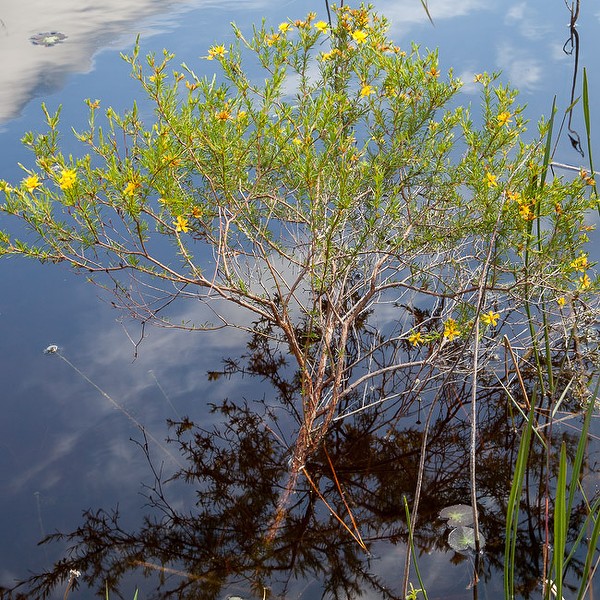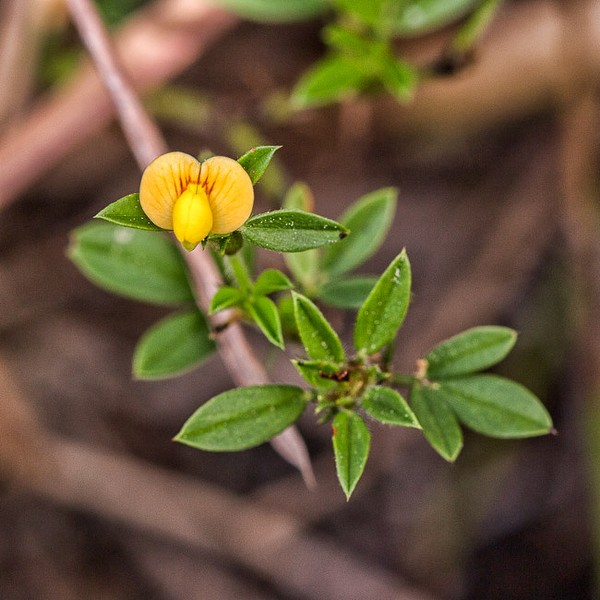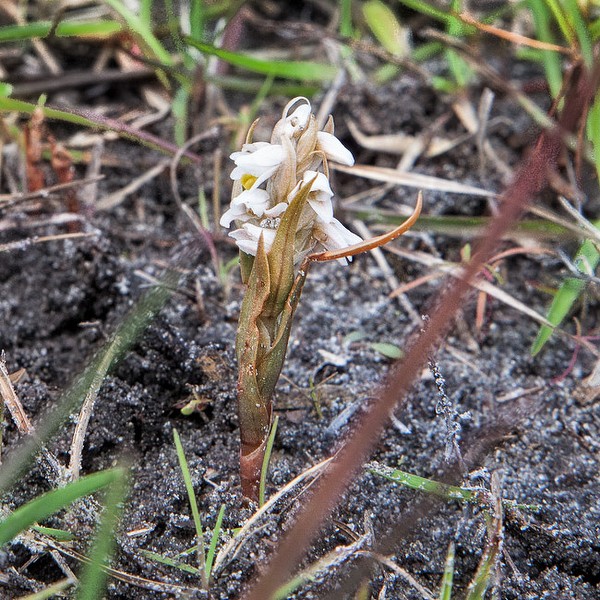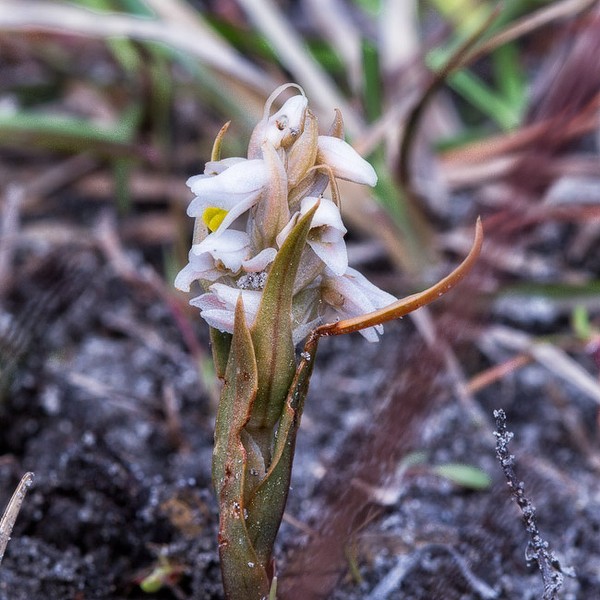Lawn Orchid, Soldiers Orchid
Zeuxine strateumatica
Orchidaceae
When I think of Orchids, I think of jungle epiphytes, or exotic fieldtrips, or corsages, or my brother’s flowery greenhouse (and the morons who broke into it recently probably looking for pot, only to leave the doors open in an 8-degree Michigan night).
Or, more botanically speaking, I think of the largest plant family that has splintered itself into maybe 30,000 species famous for specialized habitat niches, dedicated pollinators, restricted fungal associates, and narrow geographic ranges. In short, voted, “least likely to be weeds.”
That “it’s not us” perception seems fundamental to the enormous world trade in Orchids, shuffling the Franken-hybrid and species plants all over the place surprisingly unrestricted and with little thought to potential escape into natural habitats. Too bad that invasive exotic Orchids exist and seem to be getting worse.
Which Orchids dominate the commercial and hobby trade? Answer: The ones with broad tolerances and flexible needs. Same reason so many other exotics have become invasive. And much like the spores of weedy ferns, Orchid seeds are dust blowin’ in the wind. Every warm climate worldwide has Orchid enthusiasts, and cultivated Orchids are getting loose with documented adverse effects, for instance, disease spreading from invasive species to native Orchids. Epipactis helleborine is a good-old weedy species across cool latitudes. Disa bracteata is a self-pollinated nuisance ground Orchid in Australia. And new pests are turning up, perhaps most alarmingly in Hawaii.
Even though most Orchids are too constrained by their local pollinators and fungal associates to venture untended outside their normal ranges, some are self-pollinated or able to form seeds unpollinated. Some find new pollinators, such as the Brazilian Parana Cowhorn Orchid Cyrtopodium flavum (C. polyphyllum) sneaking into Florida aided by an exotic bee (reported in Botany 88: 290. 2010). Some weedy Orchids bring their fungal associates with them, or find new consorts.
My three most recent Orchid encounters in local wild areas were weedy Orchids, probably all non-native species. (The exact nativity of species with dustlike wind-blown seeds, and of weedy species in general can be unclear.) On our class field trip yesterday a sharp-eyed student spotted a pretty Orchid. How nice! At that moment I was unsure of the identity, but at home later with resources in hand, realized it was Eulophia graminea, an invasive Asian species. In the same class, the students had previously spotted Monk Orchid, Oeceoclades maculata, an invasive weedy reportedly alien species CLICK with distinctive blotched (maculata) foliage. This weed extends from Africa (see comments) to Tropical America, and into the Caribbean and Florida. I wonder if Global Warming is helping a northward progression, only a vague hunch. A quick search of the Florida Atlas of Vascular Plants turns up a baker’s dozen non-native Orchids.
The feral Orchid trend continued today. John and George just can’t stay out of Jonathan Dickinson State Park—such a lovely destination in the cool sunshine with Pawpaws, Gallberries, St. Johnsworts, Water Lilies, Silkgrass, and Marsh-Pinks in bloom.
As we stepped out of the car, hey look, an Orchid. Lawn Orchid, Zeuxine strateumatica it was. The invasive exotic Old World species decorates lawns and disturbed moist spots in several southern states. In cultivation it can be medium-magnificent. When escaped, it looks pretty but unassuming.
The species ranges more or less naturally (?) from the Middle East to the Pacific Islands, and has spread beyond. The first U.S. report dates to 1936 near Fellsmere, Florida. Harvard University researchers in the 1940’s (see citation below) surmised speculatively that the Orchid hitchhiked here with imported Centipede Grass around WWI but failed to spread at first because its usual fungal associate was not sufficiently established locally. By almost WWII, the necessary fungus, Rhizoctonia mucoroides, had a local foothold, and the Orchid-fungus duo spread with alacrity. Dig this: The Orchid’s seeds germinate only in the presence of the fungus, which researchers isolated from the Zeuxine in Florida and in its native Java.
Multiple botanists explain Zeuxine’s viable seeds without a known local pollinator as probable self-pollination and/or seed formation without benefit of pollination. Such (apomictic) seeds contain a clone of the mother plant. Determining if the plants self-pollinate or produce seed-borne clones is a feasible student research project.
Lawn Orchid comes and goes mysteriously. John and I often park where we encountered it, but have never seen the little imp there previously. The first time I saw the species was in masses behind a store in Jupiter. It vanished. I wonder if the “here today gone tomorrow” behavior explains Linnaeus’s name, “Orchis strateumatica,” with strateuma in Greek a roving band or regiment of soldiers. The plant’s basic lifestyle explains the peek-a-boo: There is an underground stem rooted at one end, with the opposite end capable of rising up and flowering. After coming up like a periscope, the flowery end dies down out of sight. At that time the fungus presumably sustains the subterranean stem saprophytically until some environmental cue says, “up-periscope.”
————————————————————————————————————————–
Note:
An account of the biological side of the Zeuxine strateumatica invasion appears in Mycologia 34: 380-390. 1942.




Steve
March 1, 2014 at 6:48 pm
I too have observed Zeuxine in undisturbed habitat way deep in the Big Cypress National Preserve. I am not sure it negatively influences existing vegetation though, it is fairly puny. But in my mind, there is no doubt that it is exotic.
Oeceoclades maculata is one of those things that might be native. Not because it was here before the Spanish, but it seems to be a natural range extension from across Africa. Over time it arrived in Brazil, then later up through the Caribbean, and now Florida. I believe it was first collected on a shell mound deep in the Everglades. It is kind of the cattle egret of the plant world, Although, it doesn’t need human disturbance (or exotic animals) to thrive as cattle egrets do.
Many of our native orchids have African affinities, off the top of my head there are Eulophia alta, Pteroglossaspis ecristata, Bletia purpurea and B. patula..
George Rogers
March 1, 2014 at 9:31 pm
Steve, Thank you for extending the info. Always puzzling to see African-New World disjunctions, although commonplace I guess in my recent fascination with weeds, so, hmmm, I guess a case in point. Glad you pointed out the transatlantic distribution of “Monk Orchid.” As with the dustlike spores of ferns, dusty Orchid seeds no doubt get around plenty airborne, and certainly Africa dust has been blowing across for a long time—just that Orchids aren’t as handy establishing in new haunts as ferns. I usually doctor up the posts after an incubation period, and made some edits influenced by your new input.
Martin
March 2, 2014 at 5:58 am
Very interesting, George. A pretty big bunch of that E. graminea showed up in some mulch at my house a few years years ago, flourished and flowered for a while, and then disappeared. And I’ve seen the little Lawn Orchid for a long time, but I never really gave thought to the possibility of these exotics actually being invasives.
George Rogers
March 2, 2014 at 6:44 am
Hi Martin, That crazy little Lawn Orchid is “all over the place,” most of FL and a good chunk of the South, not a bad dispersal pattern for a human lifetime, starting near Vero Beach. Wow, the Park has been busy. We had to stand in line to buy our chips and sandwiches in the store.
Mary Hart
March 6, 2014 at 5:15 am
UK boasts a number of wild orchids, especially in old grasslands, so they are beautiful, protected, and increasinng again, I love them. St John’s wort is another old native – check Gerards Herbal (?)
George Rogers
March 6, 2014 at 10:55 am
And I would dearly love to see them. There wildflowers are cherished and protected. In FL we build condos and golf courses over them. I will check Hypericum in Gerard. I’m at home until Monday and the book is in my office though.
prautenkranz
March 13, 2014 at 10:01 am
I have seen on many different occasions these weedy orchids. I thought they looked like orchids, but did not understanding that they could cultivate so easily. I have seen them in all sorts of locations. In lawns, beds, or just in other random locations….like weeds. And like you stated, if left alone, or mowed over, they seem to randomly come and go. Since they are so pretty, and don’t seem to over-run most lawns or beds, I never considered them a weed. Now, I am actually going to pay closer attention to those pretty little weeds,and get closer to examine them. I probably see them every day, and didn’t realize it! What an eye opener!
George Rogers
March 13, 2014 at 10:05 am
Yes, sort of counter-intuitive. First time I saw them…a weedy orchid? Weird
Jennifer Foglia
March 13, 2014 at 1:02 pm
I was going to post last week about the eulophia graminea we found but you beat me to it! Thank you for all the useful information, I really enjoyed reading about them. The information I got from my orchid society members was exactly what you said. They said it’s brought over in mulch and grows under shrubs and such, some say its blown over from Africa, I say orchid gnomes bring them over and plant them when nobody is looking. Either way it is an invasive but being an orchid enthusiast, I’ll happily take them all home. I know its against the law to remove anything from a state park, even a pine cone, but what about taking an invasive species? Does that count? It would be no different than killing a lionfish while snorkeling in a state park….at least that’s my thought on it. Also, is it spelled eulophia graminea or Eupholia Graminia? I know its an invasive as are the Australian Pines (I was surprised to find out that they aren’t a true pine), but I love them both.
George Rogers
March 13, 2014 at 1:09 pm
Jennifer, Thanks for the input. Any time you want basic data and photos for a species growing wild, this is a great source: http://florida.plantatlas.usf.edu/Plant.aspx?id=4276
As with all widespread weeds, I’d be very suspicious of statements of how they arrived, or when, etc. Weeds get around, and Orchids have dustlike seeds capable of blowing vast distances.